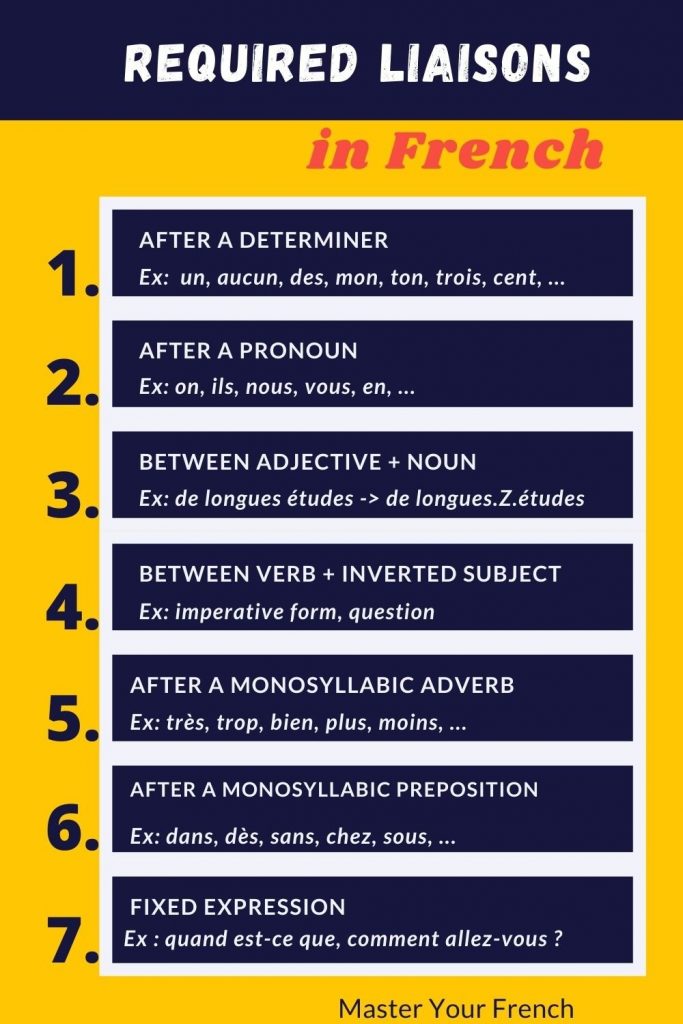Required liaisons in French: what they are and how to pronounce them
Updated: 19 September, 2023 by Mylene in Pronunciation Lessons ▪

What is a Liaison in the French language?
When a word ends with a consonant that is normally not pronounced, a liaison in French is made by pronouncing the consonant if the word that follows begins with a vowel or silent h. In making the liaison, the consonant that is pronounced becomes part of the syllable of the following word.
In this post, you’ll learn:
- The types of liaisons in French
- Conditions in which a liaison is mandatory
- Mandatory liaisons & French Pronunciation (a video)
- What Are The Sounds Of The Liaison?
How many and what types of French liaisons are there?
There are three types of liaisons in French. In fact, a liaison is not always made whenever a word ends in a consonant. A French liaison can be:
- A mandatory liaison (liaison obligatoire)
- A forbidden liaison (liaison interdite)
- An optional liaison (liaison facultative)
In this article, we’ll study the mandatory French liaisons and the sounds made by these liaisons. The more you pronounce the liaisons, the closer you will get to the rhythm of the French language.
Click on the following link to learn more about all the sounds in French with the international phonetic alphabet.
Conditions in which a liaison is mandatory in French
1. Mandatory liaisons after a determiner
The determiner can be in the singular form, in the plural form, or a numeral. The liaison is mandatory in French between the determiner and the adjective:
The word admirable is an adjective, you need to pronounce the liaison between the determiner un and the adjective admirable. The letter -n is pronounced /n/.
- Un admirable officier is pronounced: un.N.admirable officier (an admirable officer)
The liaison is mandatory in French between the determiner and the noun:
- Des enfants is pronounced: des.Z.enfants révélations (children)
Let’s see more sentences where the French liaison is required.
After a singular determiner
The liaison is mandatory with a singular determiner such as un, aucun, mon, ton, son. For example:
- Un ami is pronounced: un.N.ami (a friend)
- Mon appel is pronounced: mon.N.appel (my call)
After a plural determiner
The liaison is mandatory with a plural determiner such as les, aux, mes, tes , ses, ces, quels, quelles, certains, certaines, différents, différentes, divers, diverses, quelques and plusieurs. For example:
- Les oiseaux is pronounced: les.Z.oiseaux (the birds)
- Aux environs is pronounced: aux.Z.environs (around)
After numerals
The liaison is mandatory with the French numerals: deux, trois, vingt, cent. For example:
- Cent ans is pronounced: cent.T.ans (100 years)
- Trois abeilles is pronounced: trois.Z.abeilles (3 bees)
2. Mandatory liaisons after a pronoun
Between the subject pronoun and the following verb
The relevant pronouns that produce a liaison are: on, nous, vous, ils and elles. For example:
- On aime is pronounced: on.N.aime (we like)
- Ils attendent is pronounced: ils.Z.attendent (they wait)
You need to correctly pronounce the liaison. Otherwise, you won’t hear the difference between ils aiment (they like) vs il aime (he likes).
After a complement pronoun
The liaison is required in French when the preceding pronoun is the direct or indirect object of the verb. For example:
- Elle vous adore is pronounced: elle vous.Z.adore (she loves you)
- Il nous appelle is pronounced: il nous.Z.appelle (he calls us)
- Je les attends is pronounced: je les.Z.attends (I’m waiting for them)
With the pronoun en
With the pronoun en the liaison is required as in the following two sentences in French:
- J’en ai besoin is pronounced: j’en.N.ai besoin (I need it)
- Il en a pris is pronounced: il en.N.a pris (he took it)
3. Required liaisons between an adjective and the following noun
The liaison is required between the adjective and the following noun. For example:
- De longues études is pronounced: de longues.Z.études (long studies)
- Un premier étage is pronounced: un premier.R.étage (first floor)
- Un grand avantage is pronounced: un grand.T.avantage (a big advantage)
4. Required liaisons after a verb
Between the verb in the imperative and the following en or y
Whenever a verb is in the imperative form, the liaison must be made with the pronouns en or y as follows:
- Prends-en is pronounced: prends.Z.en (take some)
- Vas-y is pronounced: vas.Z.y (go ahead)
Between the inverted subject and the verb in the interrogative
A liaison is mandatory in French between the inverted subject and the verb in the interrogative form. Here are two sentences that illustrate this specific case:
- Ont-ils réussi? is pronounced: ont.T.ils réussi? (did they succeed?)
- Que mangent-elles? is pronounced: que mangent.T.elles? (what are they eating?)
With impersonal il est and c’est
Another case in which a liaison must be made in French is after the impersonal il est and c’est. As indicated, the liaison is compulsory in what follows:
- Il est évident is pronounced: il est.T.évident (it’s obvious)
- C’est amusant is pronounced: c’est.T.amusant (it’s amusing)
5. Required liaisons after a monosyllabic word
After a monosyllabic adverb: très, trop, bien, plus, moins.
Below are a few examples in which a liaison is required in French. In this case, the realization of the liaison is required after a monosyllabic adverb:
- Trop heureux is pronounced: trop.P.heureux (too happy)
- Bien amusé is pronounced: bien.N.amusé (amused)
- Très intéressant is pronounced: très.Z.intéressant (very interesting)
- Plus occupé is pronounced: plus.Z.occupé (busier)
The French word plus has multiple pronunciations, and it’s important to understand these variations. Simplified pronunciation rules for the word plus can help learners easily grasp the different ways to pronounce “plus” in French.
After a monosyllabic preposition: dans, dès, en, sans, chez, sous.
Another situation to pronounce a required liaison in French is the monosyllabic preposition. For example:
- Chez elle is pronounced: chez.Z.elle (at her home)
- Dans un instant is pronounced: dans.Z.un.N.instant (in one moment)
- Sous un arbre is pronounced: sous.Z.un.N.arbre (under a tree)
9 rules to know about mandatory liaisons in French
Check the video below where I go over the mandatory liaisons in French: Mandatory Liaisons — 9 rules to improve your French pronunciation.
Watch this video to learn the rules about mandatory liaisons in French. To follow more updates, subscribe to the YouTube channel and follow me on Instagram.
6. Mandatory liaisons within a fixed expression
The liaison is compulsory on the two following sentences
- Quand est-ce que tu arrives? is pronounced: Quand.T.est-ce que tu arrives? (When do you arrive?)
- Comment allez-vous? is pronounced: Comment.T.allez-vous? (How are you?)
Set phrases
There are a lot of set phrases that you need to learn. The liaison is mandatory with the following sentences, as they are considered set phrases in French. Below are a few examples:
- De plus en plus is pronounced like de plus.Z.en plus (more and more)
- De temps en temps is pronounced like de temps.Z.en temps (from time to time)
- Avant hier is pronounced like avant.T.hier (the day before yesterday)
- De mieux en mieux is pronounced like de mieux.Z.en mieux (better and better)
- Aux Etats-Unis is pronounced like aux.Z.Etats.Z.Unis (in the US)
- Petit à petit is pronounced like petit.T.à petit (little by little)
- C’est-à-dire is pronounced like c’est.T.à-dire (meaning)
- Un sous-entendu is pronounced like un sous.Z.entendu (implied)
- Tout à coup is pronounced like tout.T.à coup (suddenly)
- Tout à l’heure is pronounced like tout.T.à l’heure (in a while)
Learn more about the different ways to pronounce the French word tout.
What are the sounds of the liaison?
[z] after s, x, z :
- Les amis is pronounced: les.Z.amis (friends)
- Six ans is pronounced: six.Z.ans (6 years)
- Chez eux is pronounced: chez.Z.eux (at their home)
[t] after t,d :
- Il est intelligent is pronounced like il est.T.intelligent (he’s clever)
- Un grand homme is pronounced like un grand.T.homme (a big man)
[n] after n :
- Un ami is pronounced like un.N.ami (a friend)
- On a is pronounced like on.N.a (we have)
[ʁ] after r:
- Un léger incident is pronounced like un léger.R.incident ( a small incident)
[p] after p:
- Beaucoup aimé is pronounced like beaucoup.P.aimé (very loved)
Required liaisons: A summary
In this article, we covered the conditions in which a liaison is required in French:
- Mandatory liaisons after a determiner
- Mandatory liaisons after a pronoun
- Required liaisons between an adjective and the following noun
- Required liaisons after a verb
- Required liaisons after a monosyllabic word
- Mandatory liaisons within a fixed expression
The image below illustrates the conditions around the required liaisons in French.

Beyond Liaisons: Let’s connect
There are also many specific cases around the pronunciation of the liaison in French, such as the pronunciation of nasal vowels in liaisons. For this, I recommend that you check this article French nasal vowels in liaisons.
The best way to keep perfecting your French pronunciation is to think of this as a progressive evolution that takes place over a period of time, and as you practice every day, the journey toward fluency in French continues to move forward.
If you’d like to learn better the right French pronunciation, you can get the French pronunciation course right now.
If you enjoyed the content of this article, as well as the video, please subscribe to Master Your French on YouTube.



Merci beaucoup, Mylene.
Après tant d’années d’étudier le français, vous m’avez éclairé un tas de doutes.
Une question : vous offrez des courses de conversations en ligne?
À bientôt,
Ian
Bonjour Ian, je vous remercie tout d’abord pour votre message. Je suis ravie de savoir que cet article vous a éclairé. Je propose des leçons privées d’accompagnement à la maitrise de la prononciation (https://www.masteryourfrench.com/private-french-lessons/) et j’anime également un club de lecture (https://www.masteryourfrench.com/book-club/).
Cordialement,
Mylène